新目标八年级上册英语Unit1Section A 1 (1a-2d)表格教案
人教新目标八年级上册英语Unit 1 Section A 1a-2d教案

Show a picture of Huangguoshu Waterfall .Ask the students questions.
What’s this?
What do you think of it?
Did you go anywhere interesting?
Step 5 pair work.
Watch the pictures and try torememberwherethey went on vacation.
Then close the books and make conversations.
Hale Waihona Puke A:Where did Tina go on vacation?
Did you have a good time?
Step2: Learn new words.
T: This summer my friends also went on vacation .where did they go on vacation?
Show the pictures and ask:
--Did you go out with anyone? --Yes ,I did ./No,I didn’t.
Ability aims:Listening skill; Speaking skill ; Communicative skill.
Moral aims:Enjoy yourselves in your vacation . Visit and love our country. Learn much from the world.
Then check the answers.
人教版英语八年级上册 Unit 1 Section A (1a-2c)教学设计(表格式)
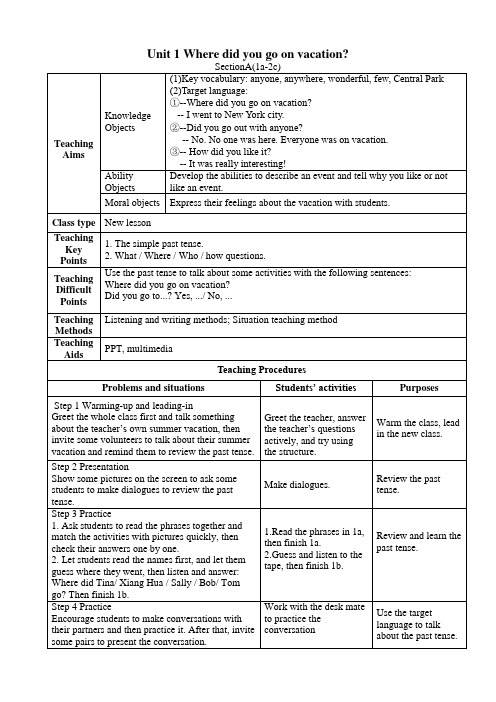
Listen and complete thechart.
Work with the desk mate to practice the conversation
Use the target language to talk about the past tense.
Step 5ListeningPractice
1.There are three students. They went to different places on vacation. There are also some questions about them. (Explain the questions in 2b to the students).Listen to the tape and please write down the places and check yes or no for each questions.
Unit 1 Where did you go on vacation?
SectionA(1a-2c)
Teaching Aims
Knowledge Objects
(1)Key vocabulary: anyone, anywhere, wonderful, few, Central Park
(2)Target language:
Teaching Procedures
Problems and situations
Students’ activities
Purposes
Step 1 Warming-up and leading-in
人教版八年级英语上册教学设计:Unit1SectionA(1a2d)

b.总结文章的主旨大意。
c.仿照文章的结构,编写一段关于自己日常生活的描述。
4.课后反思:请学生反思本节课的学习过程,总结自己在学习一般现在时和动词短语方面的收获和不足,并提出改进措施。
3.通过听力训练,提高学生对英语语音、语调的敏感度,培养良好的听力习惯,提高听力理解能力。
4.能够运用阅读策略,如预测、扫描和略读,快速获取文章主旨和细节信息。
5.提高学生的写作能力,能够运用所学句型和词汇进行简短的段落写作。
(二)过程与方法
在本章节的教学过程中,学生将通过以下方法提升学习能力:
1.采用任务型教学法,让学生在真实语境中运用英语进行交流,提高学生的语言运用能力。
人教版八年级英语上册教学设计:Unit1SectionA(1a2d)
一、教学目标
(一)知识与技能
在本章节的教学中,学生将掌握以下知识与技能:
1.能够听懂并准确说出与日常生活相关的动词短语,如“go shopping”,“watch TV”,“play soccer”等,以及掌握一般现在时的用法。
2.能够运用一般现在时描述日常活动和兴趣爱好,并能够运用目标词汇和句型进行简单的自我介绍。
2.小组作业:以小组为单位,共同编写一个关于日常活动的对话。要求至少包含五个不同的场景,每个场景中至少有三个句子。对话内容要丰富,用词要准确,语法要正确。
例如:
- Scene 1: At school
A: “What do you usually do at school, Tom?”
B: “I usually attend classes, do homework, and play soccer with my friends after school.”
英语八年级上册Unit1A(1a-2d)教学课件
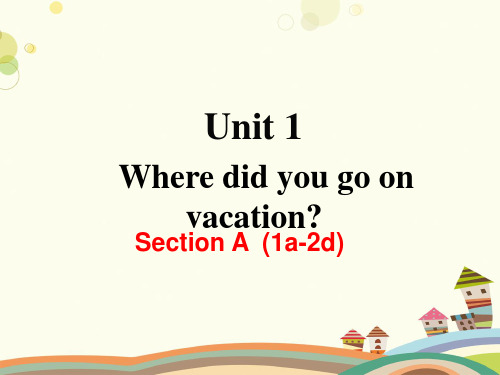
Where did you go on vacation? 你去过哪里度假?
Where did you…?是含有实义动词的一般过 去时的特殊疑问句,其句式结构:
疑问词+did+主语+动词原形+其他?
Where did they go yesterday?
When did you visit the Great Wall?
Practice
2c Role-play conversations between Grace, Kevin and Julie.
A: Grace, where did you go on vacation?
B: I went to New York City. A: Oh, really? Did you go with
buy anything special?
✔
✔ ✔
Kevin
play volleyball? swim? meet anyone interesting?
Julie
do anything interesting?
study for tests? go out with anyone?
✔ ✔ ✔
✔ ✔
Practice
1c
A: What did Tina go on vacation? B: She went to the mountains.
A: Where did … go on vacation? B: ...
went to the beach
A: Where did … go on vacation? B: ...
3.something pron.某事;某物
最新人教版八年级英语上Unit1 第一课时 Section A(1a - 2d) 教学设计
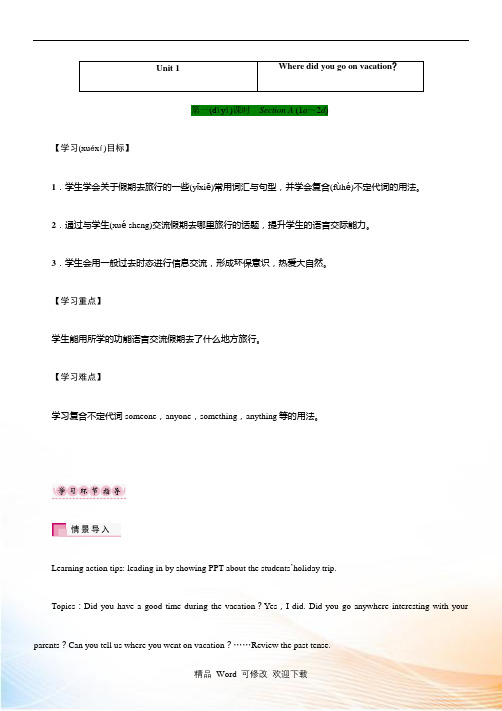
Unit 1 Where did you go on vacation?第一(dìyī)课时Section A (1a~2d)【学习(xuéxí)目标】1.学生学会关于假期去旅行的一些(yīxiē)常用词汇与句型,并学会复合(fùhé)不定代词的用法。
2.通过与学生(xué sheng)交流假期去哪里旅行的话题,提升学生的语言交际能力。
3.学生会用一般过去时态进行信息交流,形成环保意识,热爱大自然。
【学习重点】学生能用所学的功能语言交流假期去了什么地方旅行。
【学习难点】学习复合不定代词someone,anyone,something,anything等的用法。
Learning action tips: leading in by showing PPT about the students’holiday trip.Topics:Did you have a good time during the vacation?Yes,I did. Did you go anywhere interesting with your parents?Can you tell us where you went on vacation?……Review the past tense.Task 1Learning action tips: Preview the words on Page2 in the word list. Students read the words by phonetic symbols, then underline new words in the text and mark the Chinese meaning. At last finish the task in 1a.【知识(zhī shi)链接】1.复合不定(bùdìng)代词有:某人(mǒu rén)someone任何人anyone没有(méi yǒu)人no one每个人everyone某事something任何(rènhé)事anything没有东西nothing一切everything2.anyone与any one的区别anyone通常指人,侧重于个体,后面不带of;any one既指人,又指物,侧重于整体,后面可接of。
Unit1SectionA1a-2d教案(五四制)英语八年级上册
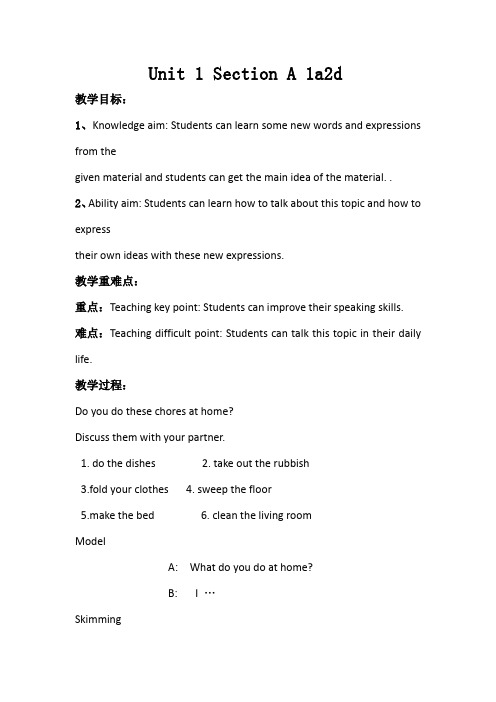
Unit 1 Section A 1a2d教学目标:1、Knowledge aim: Students can learn some new words and expressions from thegiven material and students can get the main idea of the material. .2、Ability aim: Students can learn how to talk about this topic and how to expresstheir own ideas with these new expressions.教学重难点:重点:Teaching key point: Students can improve their speaking skills.难点:Teaching difficult point: Students can talk this topic in their daily life.教学过程:Do you do these chores at home?Discuss them with your partner.1. do the dishes2. take out the rubbish3.fold your clothes4. sweep the floor5.make the bed6. clean the living roomModelA: What do you do at home?B: I …SkimmingThis means looking quickly through a piece of writing to find the main idea without reading every word. It is still a good idea to read the first sentence in each paragraph a little more carefully.They are probably about whether kids should________.A. spend time on schoolworkB. help out with chores at homeC. learn to be independent(独立的)Dear Sir,I do not understand why some parents make their kids help with housework and chores at home. Kids these days already have enough stress from school.They do not have time to study and do housework, too. Housework is a waste of their time. Could we just let them do their job as students? They should spend their time on schoolwork in order to get good grades and get into a good university. Also, when they get older, they will have to do housework so there is no need for them to doit now. It is the parents’job to provide a clean and fortable environment at home for their children. And anyway, I think doing chores is not so difficult. I do not mind doing them.Ms. MillerDear Sir,I think it is important for children to learn how to do chores and helptheir parents with housework. It is not enough to just get good grades at school. Children these days depend on their parents too much. They are always asking, “Could you get this for me?”or “Could you help me with that?”Doing chores helps to develop children's independence and teaches them how to look after themselves. Italso helps them to understand the idea of fairness. Since they live in one house with their parents, they should know that everyone should do their part in keeping it clean and tidy. Our neighbors’son got into a good college but during his first year, he had no idea how to take care of himself. As a result, he often fell ill and his grades dropped. The earlier kids learn to be independent, the better it is for their future.Mr. SmithMake conversations between Peter and his father.Ask for permission礼貌地取得同意A: Could I use your puter?B: Sorry. I'm going to work on it now.A: Well, could I watch TV?B: Yes, you can, but first you have to clean your room.homework.Help your parents do housework..Make a new conversation about housework.DiscussionQ1: Do you help your parents do the chores at home?Q2: Do you ask your parents’permission for?Q3: Do your parents ask you to do some things for them? What do your parents ask you to do?study harddo choresgo to the store/supermarket to buy things for them。
Unit1 Section A(1a-2d)教案 人教版八年级上册英语
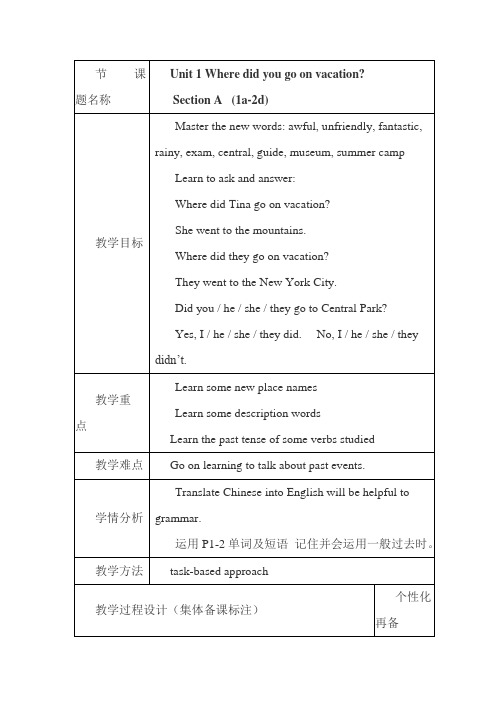
Unit 1 Where did you go on vacation?Section A (1a-2d)Step 1: Warming upActivity 1List some verbs on the blackboard. Ask students to change the words into the past forms together. Read the past forms loud.visited, went, studied, had, did, practiced,Activity 2Go on asking what you/he/she/did last weekend using the verbs they learned. Focus attention on the form of verbs.Step 2: PresentingLet students say out the verbs learnt before and help them say as many as possible. Repeat the new language points. Ask students: Did you stay at home yesterday?Did you stay at school last weekend?Where did you go on vacation?Where did your parents go on vacation?Step 3: PracticingActivity 1work in pairs. Ask and answer about where their parents, 承接七下最后一个单元的内容,继续谈论过去时。
结合刚刚过去的暑假,可以将语言学习和生活很好的结合起来。
先在课堂上畅所欲言,然后课后以布置作文的形式将所言所感写下来。
八年级英语教师集体备课教案Unit 1 SectionA(1a-2d)

Ⅷ. Role-play
1. Ask Ss to look at the picturein 2d.Then Ss read the dialogue by themselves and try to find out the answers to these questions.
4. Ss work in pairs to act out the conversation.
5. Ask some pairs come to the front of the classroom. They try to act out the conversation. See which group is the best.
老师可以和一名优秀的学生做一个对话的例子,让学生们明白如何去问答,例如:
T: What club does Lisa want to join?
S1: She wants to join the chess club.
T: Can she play chess?
S1: No, she can't.
2. Ss work in pairs to practice asking and answer about Lisa, Bob and Mary.
I can play the guitar. I can singanddance.
Ss work in groups. The let some Ss talk to their classmates infrontofthe class.
Ⅳ. Listening
1. T: Now let’s listen to the tape, find out the right conversation, and number them 1-3.
人教版初中英语八年级上册Unit 1 Section A 1a2d教案-最新教学文档

Unit 1 Where did you go on vacation?Section A 1 (1a-2d)一、教学目标:1. 语言知识目标:1)通过谈论假期活动,引导学生复习、巩固对一般过去时的理解和运用,学习有关假期活动的词汇,并能运用它们进行听说读写训练谈论假期度过的方式。
进一步掌握一般过去时的疑问句的用法,在训练、发展听说能力的同时,感知一般过去时的问答语句结构和不定代词的运用。
2)要求学生A能够掌握课标要求的“四会”的词汇:anyone, anywhere, wonderful, quite a few, most, something, nothing, everyone, of course, myself, yourselfB能掌握以下重点句型:a —Where did you go on vacation? —I went to the mountains.b —Where did Tina to on vacation? —She went to the beach.c —Did you go with anyone? —Yes, I did./No, I didn’t.C 能够了解以下语法:(1)复合不定代词someone, anyone, something, anything等的用法。
(2)yourself, myself等反身代词的用法。
(3)一般过去时态的特殊疑问句,一般疑问句及其肯定、否定回答。
(4)动词过去式的不规则变化。
2. 情感态度价值观目标:学会用一般过去时进行信息交流,培养学生的环保意识,热爱大自然,热爱生活,了解国内外著名游览胜地。
二、教学重难点1. 教学重点:1) 用所学的功能语言交流假期“去了哪儿旅行”拓展到“做过什么”。
2) 掌握本节课时所出现的新词汇。
2. 教学难点:1) 复合不定代词someone, anyone, something, anything等的用法。
人教新目标英语八年级上unit1SectionA(1a1c)教案
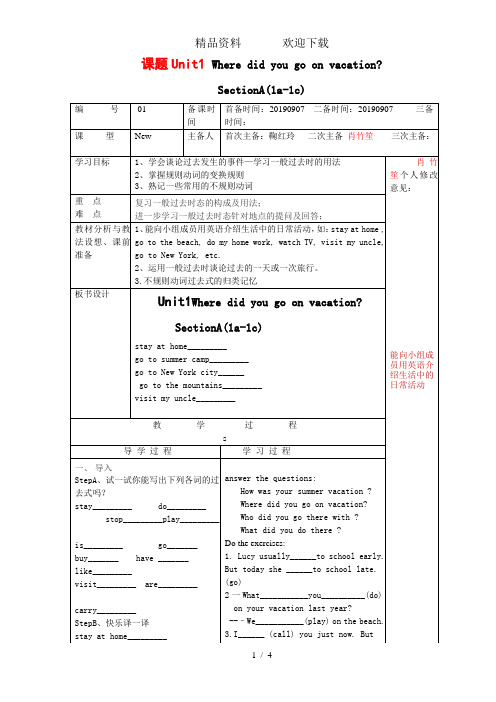
3.不规则动词过去式的归类记忆
板书设计
Unit1Where did you go on vacation?
SectionA(1a-1c)
stay at home_________
go to summer camp_________
go to New York city______
never等连用。
重点
难点
复习一般过去时态的构成及用法;
进一步学习一般过去时态针对地点的提问及回答;
教材分析与教法设想、课前准备
1、能向小组成员用英语介绍生活中的日常活动,如:stay at home , go to the beach, do my home work, watch TV, visit my uncle, go to New York, etc.
like_________ visit_________ are_________
carry_________
StepB、快乐译一译
stay at home_________
go to summer camp_________
go to New York city______
go to the mountains_________
教学札记:联系刚过去的暑假,通过对话表演方式大胆张口,敢于用英语进行交际。利用情景思维在理解句意的基础上理解词汇的用法,记忆重点词汇,句型和语法内容。形式再活泼一些,讲练多结合。
II、词语运用
—Where did he go on vacation?他去哪儿度假的?
—He stayed at home.他呆在家里。
stay at home“呆在家里”是一固定短语,类似的还有:
教学设计大赛一等奖教案-人教新目标英语八上Unit1Section A(1a-2d)

Unit 1 Where did you go on vacation?Section A 1 (1a-2d)教学设计Learning Goals:一、语言知识(常用词汇和短语)anyone, anywhere, wonderful, quite a few, most, something, nothing, everyone, of course, myself, yourself二、语言技能1)能掌握以下句型:①—Where did you go on vacation? —I went to the mountains.②—Where did Tina to on vacation? —She went to the beach.③—Did you go with anyone? —Yes, I did./No, I didn’t.2) 能了解以下语法:—复合不定代词someone, anyone, something, anything等的用法。
—yourself, myself等反身代词的用法。
3)能掌握一般过去时态的特殊疑问句,一般疑问句及其肯定、否定回答。
并能用过去时谈论过去的事情。
三、学习策略1:能利用句子重音捕捉关键信息,把握所听内容的大意。
2:能通过词义的积极性或消极性判断,理解文章中人物的感受。
3:能利用话题思维导图对词语归类整理,提高词语识记效率。
四、情感态度:学会用一般过去时进行信息交流,培养学生的环保意识,热爱大自然。
五、文化意识了解国内外著名游览胜地,如:黄果树瀑布,中央公园等。
【设计意图】目标引领,表述了本节课的知识、能力、学习策略、情感态度和文化意识。
Teaching and learning stepsStep1. Preview(教师寄语: No pains, no gains.没有付出就没有收获。
)Read from P1 to P3 and put the Chinese into English orally, then write them down without looking at your book..P1: 翻译下列短语1: 去海滩________________ 2:去爬山_______________3:待在家里____________ 4:拜访/看望…老师________5:去度假_______________ 6:参观博物馆_____________7:去参加夏令营___________P2:翻译下列句子1.好久不见。
人教版八年级上册Unit 1 Section A(1a-2d)教案

人教版初中英语八年级上册Unit 1 Where did you go on vacation?Section A 1 (1a-2d)教学设计Unit1 Section A (1a-2d) 练习一、单项选择题(共5题,共50分)1. (10分)—How was your day off?—Pretty good! I ______ the science museum with my schoolmates.A. visitedB. visitC. am visitingD. will visit2. (10分)—How was your trip to Shanghai, Jim?—Great! We _______ to Xixi National Wetland Park.A. goB. am goingC. wentD. will go3. (10分)—Did your father work in America in 1999?—_______. He worked in China.A. No, he doesn'tB. Yes, he doesC. No, he didn'tD. Yes, he did4. (10分)—July, is it OK to leave you at home by _______?—Of course, dad.A. myselfB. yourselfC. herselfD. yourselves5. (10分)I'd like to go _______.A. to peaceful somewhereB. to somewhere peacefulC. somewhere peacefulD. peaceful somewhere二、句型转换(共5题,共50分)6. (10分)—Did you clean the hallway? (作肯定回答) —Yes, _______ _______.7. (10分)Lily visited her aunt last week. (改为否定句) Lily _______ _______ her aunt last week.8. (10分)I saw an interesting show last night. (改为一般疑问句) _______ you _______ an interesting show last night?_______ _______ they _______ in the room?_______ _______ the ship trip?。
最新人教新目标英语八年级上册 Unit 1 Where did you go on vacation?教案2
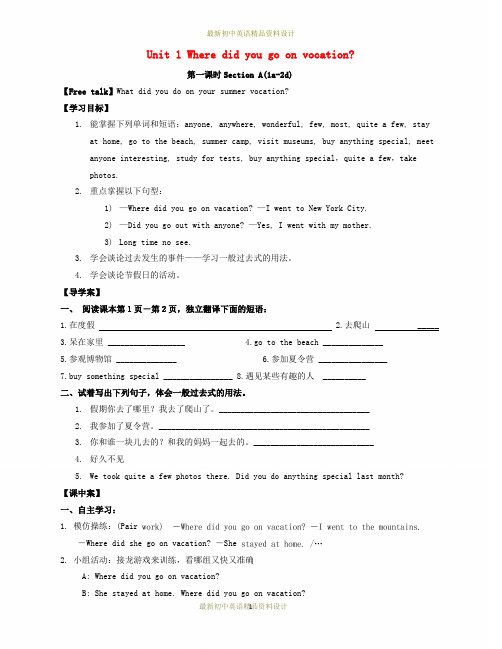
Unit 1 Where did you go on vocation?第一课时Section A(1a-2d)【Free talk】What did you do on your summer vocation?【学习目标】1.能掌握下列单词和短语:anyone, anywhere, wonderful, few, most, quite a few, stayat home, go to the beach, summer camp, visit museums, buy anything special, meetanyone interesting, study for tests, buy anything special,quite a few,takephotos.2.重点掌握以下句型:1)—Where did you go on vacation? —I went to New York City.2)—Did you go out with anyone? —Yes, I went with my mother.3)Long time no see.3.学会谈论过去发生的事件——学习一般过去式的用法。
4.学会谈论节假日的活动。
【导学案】一、阅读课本第1页-第2页,独立翻译下面的短语:1.在度假2.去爬山 _____3.呆在家里 __________________4.go to the beach ______________5.参观博物馆 ______________6.参加夏令营 ________________7.buy something special ________________ 8.遇见某些有趣的人 __________二、试着写出下列句子,体会一般过去式的用法。
1.假期你去了哪里?我去了爬山了。
___________________________________2.我参加了夏令营。
八年级英语上册(人教新目标GoForIt!)Unit1第1课时SectionA(1a2d)教学设计
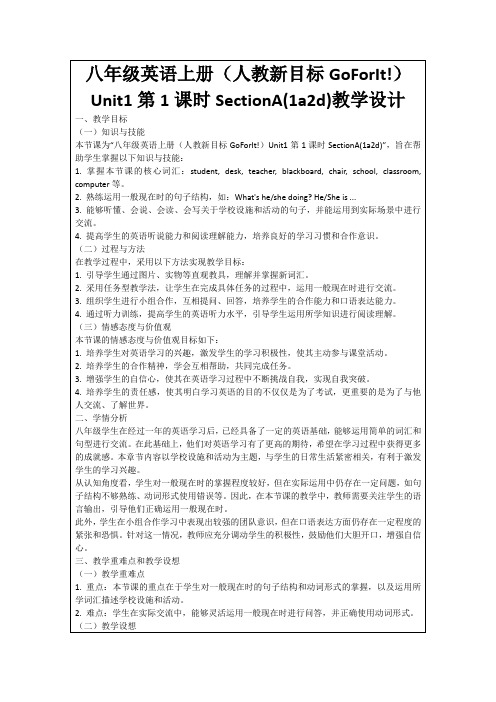
3.能够听懂、会说、会读、会写关于学校设施和活动的句子,并能运用到实际场景中进行交流。
4.提高学生的英语听说能力和阅读理解能力,培养良好的学习习惯和合作意识。
(二)过程与方法
在教学过程中,采用以下方法实现教学目标:
此外,学生在小组合作学习中表现出较强的团队意识,但在口语表达方面仍存在一定程度的紧张和恐惧。针对这一情况,教师应充分调动学生的积极性,鼓励他们大胆开口,增强自信心。
三、教学重难点和教学设想
(一)教学重难点
1.重点:本节课的重点在于学生对一般现在时的句子结构和动词形式的掌握,以及运用所学词汇描述学校设施和活动。
2.任务驱动,合作探究:
设计丰富的课堂活动,如小组讨论、角色扮演等,引导学生运用一般现在时进行交流。任务驱动教学法能够激发学生的学习动机,培养他们的合作精神和自主学习能力。
3.逐步引导,分层教学:
针对学生英语水平参差不齐的现状,教师应关注个体差异,实施分层教学。对于基础薄弱的学生,重点辅导动词形式和句子结构;对于基础较好的学生,引导他们进行更复杂的交流,提高语言运用能力。
2.难点:学生在实际交流中,能够灵活运用一般现在时进行问答,并正确使用动词形式。
(二)教学设想
为了有效突破教学重难点,提高学生的英语综合运用能力,我设想以下教学策略:
1.创设情境,激发兴趣:
利用图片、实物等直观教具,呈现学校设施和活动场景,让学生在真实语境中感知、体验和运用英语。通过情境创设,激发学生的学习兴趣,调动他们的学习积极性。
二、学情分析
八年级学生在经过一年的英语学习后,已经具备了一定的英语基础,能够运用简单的词汇和句型进行交流。在此基础上,他们对英语学习有了更高的期待,希望在学习过程中获得更多的成就感。本章节内容以学校设施和活动为主题,与学生的日常生活紧密相关,有利于激发学生的学习兴趣。
人教版新目标英语八年级上册Unit1SectionA(1a2d)教学设计
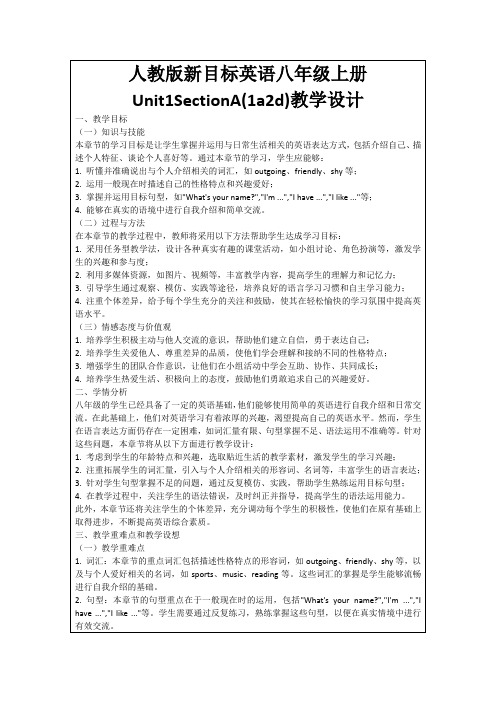
4.引导学生回顾已学的自我介绍相关内容,为新课的学习做好铺垫。
(二)讲授新知
1.教师呈现新课内容相关的图片,引导学生学习新词汇和句型。如:“This is Tom. He is outgoing and friendly. He likes playing sports and listening to music.”
三、教学重难点和教学设想
(一)教学重难点
1.词汇:本章节的重点词汇包括描述性格特点的形容词,如outgoing、friendly、shy等,以及与个人爱好相关的名词,如sports、music、reading等。这些词汇的掌握是学生能够流畅进行自我介绍的基础。
2.句型:本章节的句型重点在于一般现在时的运用,包括"What's your name?","I'm ...","I have ...","I like ..."等。学生需要通过反复练习,熟练掌握这些句型,以便在真实情境中进行有效交流。
(一)导入新课
1.教师播放一段外国学生自我介绍的视频,引导学生关注并思考视频中学生的介绍方式和内容。
2.视频播放完毕后,教师提问:“How do they introduce themselves? Can you introduce yourself in English?”,引发学生思考并尝试用英语进行自我介绍。
2.运用一般现在时描述自己的性格特点和兴趣爱好;
3.掌握并运用目标句型,如"What's your name?","I'm ...","I have ...","I like ..."等;
人教版新目标英语八年级上册Unit1SectionA(1a2d)优秀教学案例

3.在听力练习环节,提出相关问题,让学生边听边思考,锻炼他们的听力理解能力。
4.鼓励学生提出问题,引导他们主动探究,培养他们的问题解决能力。
(三)小组合作
1.组织学生进行小组讨论,让他们共同探讨不同场合下的问候方式,提高他们的团队协作能力。
2.设置小组竞赛活动,激发学生的学习积极性,培养他们的竞争意识。
5.培养学生树立正确的价值观,认识到学习英语的重要性,为他们未来的发展奠定基础。
三、教学策略
(一)情景创设
1.利用1a部分的图片,创设各种日常生活场景,如在学校、家庭、公园等地方,让学生在真实情境中学习并运用英语问候语。
2.设计角色扮演活动,让学生模拟不同场合下的问候场景,增强他们对英语问候语的感性认识。
4.教师提醒学生下节课内容,让学生提前预习,为下次课做好准备。
五、案例亮点
本节课作为人教版新目标英语八年级上册Unit1SectionA(1a-2d)的教学案例,具有以下五个亮点:
1.情景教学法的运用:教师通过创建丰富的情境,如学校、家庭、公园等,让学生在真实的环境中学习并运用英语问候语。这种教学方法有助于提高学生的语言实践能力,培养他们的交际技能。
4.学生能够通过课文学习,了解不同国家的问候习惯,拓宽文化视野。
(二)过程与方法
1.通过观察1a部分的图片,引导学生思考并讨论不同场合下的问候方式。
2.采用情景教学法,设置各种真实情境,让学生在实际操作中学会运用所学问候语。
3.组织小组活动,让学生互相练习问候语,提高口语表达能力。
4.运用多媒体教学手段,播放1d部分的听力材料,培养学生的听力技能。
人教版英语八年级上册Unit1SectionA(1a2d)教学设计

3.针对听力部分,设计类似的听力练习,让学生运用听力策略,提高听力水平。
(五)总结归纳
在总结归纳环节,我将带领学生回顾本节课的学习内容:
1.教师引导学生总结本节课学的词汇、短语、语法知识以及听力策略。
2.学生分享自己在课堂练习中的收获和体会,反思学习过程中的不足。
1.将学生分成小组,每组讨论一个旅行计划,运用所学词汇和语法结构描述计划中的活动。
2.各小组分享自己的旅行计划,其他小组进行评价,提出建议或疑问,促进互动交流。
3.教师巡回指导,关注学生在讨论中遇到的困难,并及时给予帮助。
(四)课堂练习
课堂练习旨在巩固所学知识,提高学生的实际运用能力:
1.设计填空、选择、匹配等形式的练习题,让学生运用所学词汇和语法知识完成任务。
4.提高听力、阅读技能:通过听力、阅读训练,引导学生运用学习策略,提高听力、阅读水平。
5.关注个体差异:针对不同学生的学习需求,提供个性化指导,使每个学生都能在课堂上得到提高。
三、教学重难点和教学设想
(一)教学重难点
1.词汇和短语的掌握:本节课涉及的词汇和短语如"schedule", "travel", "flight", "arrive", "depart"等,是学生描述旅行计划的基本语言材料,需要学生熟练掌握并在实际语境中运用。
3.引导学生关注旅行计划中的一些关键词汇,如“schedule”, “flight”, “arrive”, “depart”等,为新课的学习做好铺垫。
(二)讲授新知
在讲授新知环节,我将按照以下步骤进行:
英语人教新目标八年级上册人教英语八上Unit 1 Section A 1a—2d

I visited the museums.
Where did you go on vacation?
New York City
I went to New I went to the Great Wall. York City.
I visited my uncle.
1.stayed at home
Kevin, where did
you go on
I ...
vacation?
Oh, really? Did you go Yes, I ... with anyone?
2d Read the conversation and match
the people with the right place.
mountains _c_
6. went to the beach _a_
7. visited museums _e__
Listen and number the
1b
people in the picture (1-5).
1. Tina 2. Xiang Hua 3. Sally 4. Bob 5. Tom
√
Kevin play volleyLeabharlann all?√swim?
√
meet anyone interesting?
√
Julie do anything interesting?
√
study for tests? go out with anyone?
√ √
Central park 中央公园位于美国纽约中心的曼哈顿地
I went to Beijing
for vacation.
I went to summer camp.
英语 人教版 八年级上册(电子教案)Unit 1 第一课时 Section A (1a-2d)
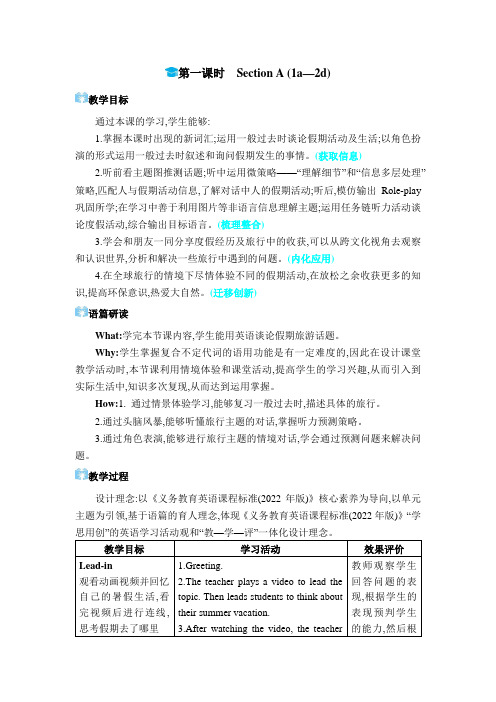
第一课时Section A (1a—2d)教学目标通过本课的学习,学生能够:1.掌握本课时出现的新词汇;运用一般过去时谈论假期活动及生活;以角色扮演的形式运用一般过去时叙述和询问假期发生的事情。
(获取信息)2.听前看主题图推测话题;听中运用微策略——“理解细节”和“信息多层处理”策略,匹配人与假期活动信息,了解对话中人的假期活动;听后,模仿输出Role-play 巩固所学;在学习中善于利用图片等非语言信息理解主题;运用任务链听力活动谈论度假活动,综合输出目标语言。
(梳理整合)3.学会和朋友一同分享度假经历及旅行中的收获,可以从跨文化视角去观察和认识世界,分析和解决一些旅行中遇到的问题。
(内化应用)4.在全球旅行的情境下尽情体验不同的假期活动,在放松之余收获更多的知识,提高环保意识,热爱大自然。
(迁移创新)语篇研读What:学完本节课内容,学生能用英语谈论假期旅游话题。
Why:学生掌握复合不定代词的语用功能是有一定难度的,因此在设计课堂教学活动时,本节课利用情境体验和课堂活动,提高学生的学习兴趣,从而引入到实际生活中,知识多次复现,从而达到运用掌握。
How:1. 通过情景体验学习,能够复习一般过去时,描述具体的旅行。
2.通过头脑风暴,能够听懂旅行主题的对话,掌握听力预测策略。
3.通过角色表演,能够进行旅行主题的情境对话,学会通过预测问题来解决问题。
教学过程设计理念:以《义务教育英语课程标准(2022年版)》核心素养为导向,以单元主题为引领,基于语篇的育人理念,体现《义务教育英语课程标准(2022年版)》“学言,让教师把握学情【应用实践】板书设计作业设计基础型作业:Choose different feelings and make conversations about your last vacation.实践型作业:Make a travel log.拓展型作业:Search information about Hong Kong.教学反思。
- 1、下载文档前请自行甄别文档内容的完整性,平台不提供额外的编辑、内容补充、找答案等附加服务。
- 2、"仅部分预览"的文档,不可在线预览部分如存在完整性等问题,可反馈申请退款(可完整预览的文档不适用该条件!)。
- 3、如文档侵犯您的权益,请联系客服反馈,我们会尽快为您处理(人工客服工作时间:9:00-18:30)。
B: I went to…
A: Did you see…
B: Yes, I did. / No, I didn’t.
板书
设计
Section A 1 (1a-2d)
anyone, someone, everyone, something, anything, everything
2)能了解以下语法:
—复合不定代词someone, anyone, something, anything等的用法。
—yourself, myself等反身代词的用法。
3)一般过去时态的特殊疑问句,一般疑问句及其肯定、否定回答。
2.情感态度价值观目标:
学会用一般过去时进行信息交流,培养学生的环保意识,热爱大自然。
go out with anyone?
4、Play the recording a second time for the Ss to check“Yes, I did.”or “No, I didn’t.”
作业
设计
Homework:
用英语询问你的一位好朋友,她(他)假期去了哪里?看到了什么?并将此对话写在作业上。
VII. Role-play
1. First let Ss read the conversation and match the people and places they went.
2. Let Ss act out the conversations in pairs.
3. Some explanations in 2d.
学校电子备课模板
教学内容
Unit 1 where did you go on vacation?
Section A 1 (1a-2d)
课 型
新授课
授课时间
第 一 周第 2 课时
备课教师
总 课 时
总第 2 课时
任教学科
英 语
教学目标
1.语言知识目标:
1)能掌握以下单词:anyone, anywhere, wonderful, quite a few, most, something, nothing, everyone, of course, myself, yourself
visited my uncle,
visited museums,
went to summer camp
4. Check the answers.
And listen to the tape again.Try to repeat the sentences
.
Did you…
Yes, I did.
No, I didn’t
4. Check the answers.
IV.Pair work
1. Point out the sample conversation. Ask two Ss to read the conversation to the class.
2. Now work with a partner. Make your own conversation about the people in the picture.
Grace
go with anyone?
go to Central Park?
buy anything special?
Kevin
play volleyball?
swim?
meet anyone interesting?
Julie
do anything interesting?
study for tests?
教学重
点难点
1.教学重点:
1)用所学的功能语言交流假期去了什么旅行。
2)掌握本课时出现的新词汇。
2.教学难点:
1)复合不定代词someone, anyone, something, anything等的用法
—yourself, myself等反身代词的用法。
教学流程
二次备课
Ⅰ. Lead-in
1.看动画片来进入本课时的主题谈论上周末做了些什么事情,谈论过去发生的事情。
Ask: What did the person do in each picture?
2. Play the recording the first time.
3. Play the recording a second time.
Say: There are three conversations. The people talk about what did on vacation. Listen to the recording and write numbers of the names in the right boxes of the picture.
She went to the mountains.
something a person did in the past. Name each activity and ask students to repeat:
Stayed at home, Went to mountains, went to New York City 6. Went to the beach,
3. Ss work in pairs. As they talk, move around the classroom and give any help they need.
4. Let some pairs act out their conversations.
V. Listening
1. Tell Ss they will hear a conversation about three students’conversations. Listen for the first time and fill in the chart. Then listen again and check Yes, or No.
能掌握以下句型:
①—Where did you go on vacation?—I went to the mountains.
②—Where did Tina to on vacatio—Did you go with anyone?—Yes, I did./No, I didn’t.
根据学生实际询问
What did you do on vacation?
引导学生回答
I went to the mountains.
......
反复读并熟悉该板块的短语
抽查学生掌握情况
Stayed at home,
Went to mountains,
went to New York City
Went to the beach,
4. Check the answers. Answers: 1. f 2. b 3. g 4. e 5. c 6. a 7. d
III. Listening
1. Point to the picture on the screen.
Say: Look at the picture A. Where did Tina go on vacation? She went to mountains.
1. Let two Ss read the conversation between Grace, Kevin and Julie.
2. Let Ss work in pairs and try to role-play the conversation.
3. Ask some pairs to act out their conversations.
Ⅱ. Presentation
1. Show some pictures on the big screen. Let Ss read the expressions.
2. Focus attention on the picture. Ask: What can you see? Say: Each picture shows
visited my uncle, visited museums, went to summer camp
3. Now, please match each phrase with one of the pictures next to the name of the
activity,point to the sample answer.
2. Let Ss read the phrases in the chart of 2b.
3. Play the recording the first time. Ss listen and fill in thechart.
4. Check the answers with the Ss.
VI. Pair work
yourself, myself
Where did you go on vacation?Did you do anything special?
I went to New York City.Did you go anywhere interesting?
Where did she go on vacation? most of the time
